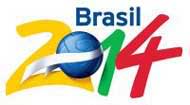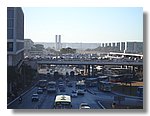Buses in Brasilia
Brasilia is one of
the host cities
of the World Cup 2014

 Brasilia
Brasilia
 Brasilia Facts
Brasilia Facts
 Transportation
Transportation

Today, the bus station is hub of urban buses only, some of which run within the Pilot Plan and others which connects the Pilot Plan to the Satellite cities. In the original plan, the inter-State buses should also stop at the central Station; however, because of the excessive growth of Brasilia (and the corresponding growth in the bus fleet), today the inter-State buses leave from the inter-State station, located at the western end of the Monumental Axis.
Notice, also, that the metro of Brasilia has a station in the bus station.
|
|
|
|
The photos above show buses in the Central Bus Station of Brasilia. The black building in the background of the photo to the left is the head office of the Central Bank of Brazil.
The bus station is very crowded during the day; beware of pick pockets. During the night, the area is best avoided.
Likewise, bus stops in Brasilia are slightly better than in other major Brazilian cities (see photo).
The bus grid of Brasilia is comprehensive; most of the Pilot Plan can be reached with just one bus, leaving from the central station; also, there are buses to all satellite cities.
Within the Pilot Plan, the two most important highways are the W3 and the L2; these highways run in parallel to the Eixão (see notes on transportation).
Some particularly useful bus routes are the Grande Circular (Big Circular), which rings all along the W3 and L2 (in both directions), and the W3-L2 North and South, which run only the Northern or Southern rings.
Bus fares depend on the distance the bus covers. Buses coming from and to the satellite cities are usually a few nickels more expensive. In 2005, prices varied from R$ 1,50 to R$ 2,50 (between US$ 0,70 and US$ 1,00).
